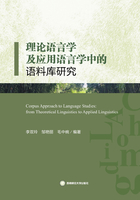
5. Conclusion
This study mainly investigates how the static verbs are used in the progressive aspect functionally. After analyzing the speaker communicative intentions and context, five main functions of the static verbs used in the progressive aspect were classified in this study:①snapping a shot of the action; ②indicating the subjective initiative of the speaker; ③emphasizing the emotions of the speaker; ④suggesting the repetition or the continuation of the action or state; ⑤referring to the future. The function, snapping a shot of the action, is used the most frequently in this corpus-based analysis. Furthermore, the data distribution of five functions associated with each of subtype of the static verbs have been discussed, which indicates different subtypes have different tendencies to associate with functions of static verbs used in the progressive aspect. The static verbs which describe cognitive status and mental attitude are frequently combined with the aspect of the progressive to emphasize their feelings or emotions and verbs of sensation and perception have a stronger association with the second function of static verbs used in the progressive aspect. Additionally, native speakers also tends to use the static verbs which originally denote state or relations to indicate the continuation of actions or state in the specific time.
This study also has some limitations which provides clues for future research directions. Firstly, the data of samples to some extent are too small. Future research could center on larger sample data and study this topic by means of synchronic and diachronic methods. Secondly, a more objective method should be adopted to the classification of the functions of static verbs used in the progressive aspect. The author may have her own mistakes or errors in judgment for there is no obvious classifying standard at present. Thirdly, this study did not dig out more information on the issue of uneven data distribution and give out specific reasons for data tendencies in Figure 2. And some assumptions should be further studied and versified with more evidences. Thus, future research could investigate more word groups and examine in depth the data distribution to find more information behind them.